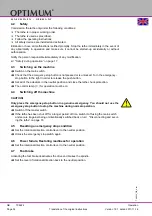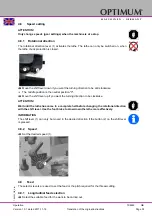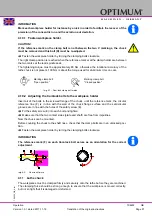
Operation
Version 1.0.1 dated 2017-11-16
Page 48
Translation of the original instructions
TX6222
GB
T
X
6222
_GB
_4.
fm
OPTIMUM
M A S C H I N E N - G E R M A N Y
®
4.19.3 Turning of cones with high precision
There are different possibilities to machine a cone on a common small lathe:
1. By twisting the top slide by setting the setting-angle with the angular scale. But there the
graduation of the scale is too inaccurate. For chamfers and conic passings the graduation of
the angular scale is sufficient.
2. By a simple calculation, a stop measure of 100mm length (of your own production) and a
gauge with stand.
Calculation
of the offset of the top slide relating to the stop measure with a length of 100 mm.
The stop measure (100mm) is to be put between a fixed unit stop and the bedslide. Put the
gauge with stand on the lathe bed and horizontally align the test prod with the test prod with
thetop slide (90° to the top slide). The twisting measure is calculated with the above mentioned
formula.
The top slide is twisted by this value (then set the gauge to zero). After removing the stop
measure, the bedslide will be aligned to the limit stop. The gauge must indicate the calculated
value "Vo" Then the workpiece and the tool are clamped and positioned (the bedslide is fixed).
Abb. 4-7: Designation on the cone
D = large diameter [mm]
d = small diameter [mm]
L = cone length [mm]
Lw = workpiece length [mm]
= cone angle
= setting angle
Kv = cone proportion
Vr = tailstock offset
Vd = measure change [mm]
Vo = twist measure of top slide [mm]
α
α
2
⁄
D
d
Lw
L
α
α
2
⁄
Step by step
by one calculation step (summary)
Example:
D = 30.0 mm ; d = 24.0 mm ; L = 22.0 mm
Kv =
L
D - d
Vd =
100mm
Kv
Vo =
Vd
2
Vo =
100mm x (D - d)
2 x L
Vo =
100mm x (30mm - 24mm)
2 x 22mm
=
100mm x 6mm
44mm
13.63mm






























